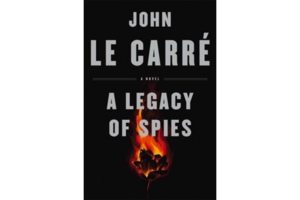'A Legacy of Spies' reminds readers why they have loved John le Carré so well and so long
Le Carré's latest novel allows him to revisit his beloved earlier novels from a gripping new perspective.

A Legacy of Spies
By John le Carré
Penguin
272 pp.
Book world marketing being what it is, John le Carré's new novel A Legacy of Spies is inevitably being taglined as “the return of George Smiley!” – shorthanding that le Carré's great signature character, the Sphinx-like spymaster at the heart of the spiderweb of the British Secret Service, nicknamed “the Circus,” is appearing in a le Carré novel for the first time in more than a quarter of a century. And taglines being what they are, this might work to sell the book but also works to sell it short. Le Carré's legion of longtime fans will know not to pay any attention to marketing or taglines, but it should be stressed for newcomers to this fantastic, paradigm-setting author that they need not be exhaustively familiar with all his earlier spy novels in order to read and enjoy "A Legacy of Spies." Such lopsided dependency would be the mark of an amateur author in any case, and le Carré is one of the most seasoned professionals in the entire world of fiction.
The novel opens in the present day. We find Peter Guillam, once the “gatekeeper and trusted disciple” of George Smiley and now a much older man living out a quiet retirement from the Circus on the Brittany coast, stewing in old memories, haunted by old ghosts. Longtime le Carré readers will remember Guillam as a tough-guy operative from the author's genre-defining 1963 novel "The Spy Who Came in from the Cold." In that novel, Guillam played a key role in the Operation Windfall, which culminated in one of spy fiction's indelible scenes, the deaths of Guillam's fellow agent Alec Leamas and his lover Liz Gold, shot dead at the Berlin Wall.
It's an old, scarred-over memory for Guillam, but an imperious summons reaches Brittany from London, heavy-handedly “requesting” that he come and answer some new questions about Windfall. He returns to a Circus now staffed by people for whom the Cold War is a matter for dusty textbooks, and he's greeted by a particularly oily specimen, “a fresh-faced, bespectacled, English public schoolboy of an indefinite age” called Bunny who wants to go over with him the tragedy of Windfall in exacting detail – spurred by vindictive lawsuits filed by the children of Alec Leamas and Liz Gold. “The historic blame game,” Bunny calls it with forced cynicism. “Our new national sport. Today's blameless generation versus your guilty one. Who will atone for our fathers' sins, even if they weren't sins at the time?”
In order to fend off these lawsuits, the current masters of the Circus must know the gritty, undisclosed reality behind Operation Windfall. Guillam must not only relive it but amplify it, and the lawsuits themselves might have dark forces behind them. In other words, the premise of "A Legacy of Spies" is as elegant and simple as a hydrogen molecule; it allows fans of "The Spy Who Came in from the Cold" and "Tinker, Tailor, Soldier, Spy" to revisit those beloved novels from a gripping new perspective without feeling the guilt of lazy nostalgia, and it allows le Carré himself to return to the story of his most famous novels without seeming like a check-cashing opportunist.
The questions of legal culpability are new to the world of le Carré spycraft, and it's clear from the outset of the novel that, Bunny's sarcasm notwithstanding, le Carré hardly considers the squeaky-clean new generation to be blameless. In "The Spy Who Came in from the Cold," espionage agents are scathingly referred to as “a squalid procession of vain fools, traitors too, yes; pansies, sadists and drunkards, people who play cowboys and Indians to brighten their rotten lives,” but in "A Legacy of Spies," they are very much the knights errant of the Cold War era, taking the risks and making the hard choices in order to shield civilians from the violence and chaos always being marshaled in the shadows. Such struggles mean nothing to a bureaucrat like Bunny, who obviously considers Guillam and his old colleagues every bit as guilty as the operatives they opposed. “You were assigned,” he tells Guillam, “– let us say by the impeccable George Smiley – to covert operations where the death of innocent people was considered an acceptable, even necessary outcome. Even, who knows, a desired one.”
The only drawback to "A Legacy of Spies" is this newly sharpened contrast between black and white. No matter how many dark revelations come to light about Operation Windfall, readers are never allowed to think of Guillam – or the rest of Smiley's people – as anything other than righteous titans of a morally clearer era. It feels like a simplification of the ethical ambiguity that gave the earlier books their disturbing appeal.
Peter Guillam here is a spy in winter, and Smiley himself is a ghost confined to a few brief scenes, mostly present in the book as a memory. However unattractive such an idea may be to new and old fans alike, "A Legacy of Spies" feels like a grandmaster's farewell performance.

